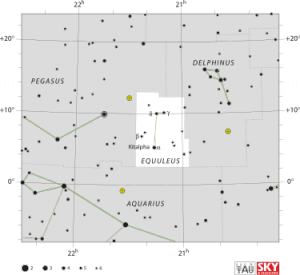Equuleus: Difference between revisions
| Line 13: | Line 13: | ||
HGS Sessions - Clearing [[Hyperspace Phantom Matrix]] - 3/12/2015 <ref>[http://www.energeticsynthesis.com/index.php/forum/52-hgs-discussions-and-q-a-a/60650-hgs-shared-sessions-and-discussion?start=126h HGS Session]</ref> | HGS Sessions - Clearing [[Hyperspace Phantom Matrix]] - 3/12/2015 <ref>[http://www.energeticsynthesis.com/index.php/forum/52-hgs-discussions-and-q-a-a/60650-hgs-shared-sessions-and-discussion?start=126h HGS Session]</ref>HGS Sessions - Clearing [[Tara, Gaia, Cradle of Lyra]]- 3/12/2015 <ref>[http://www.energeticsynthesis.com/index.php/forum/planetary-emancipation-gridwork-peg/60919-documenting-hgs-sessions-for-peg-gridwork?start=42#101308 HGS Session]</ref> | ||
==References== | ==References== | ||
Revision as of 23:16, 20 March 2015
Equuleus is a constellation. Its name is Latin for 'little horse', a foal. It was one of the 48 constellations listed by the 2nd century astronomer Ptolemy, and remains one of the 88 modern constellations. It is the second smallest of the modern constellations (after Crux), spanning only 72 square degrees. It is also very faint, having no stars brighter than the fourth magnitude.[1]
Mythology
In Greek mythology, one myth associates Equuleus with the foal Celeris (meaning "swiftness" or "speed"), who was the offspring or brother of the winged horse Pegasus. Celeris was given to Castor by Mercury. Other myths say that Equuleus is the horse struck from Poseidon's trident, during the contest between him and Athena when deciding which would be the superior. Because this section of stars rises before Pegasus, it is often called Equus Primus, or the First Horse. Equuleus is also linked to the story of Philyra and Saturn.Created by Hipparchus and included by Ptolemy, it abuts Pegasus; unlike the larger horse it is depicted as a horse's head alone.
History
Equuleus is the second smallest constellation in the Northern Hemisphere, tucked between the head of Pegasus and the dolphin, Delphinus. There is no certain legend applied to Equuleus and it is supposedly created by the second-century Greek astronomer Ptolemy because it was added to his Algamest, though according to Geminos (130 - 60 B.C.) it was created by Hipparchos (Hipparchus), the Greek astronomer who lived around 190-120 B.C. Hipparchus mapped the position of 850 stars in the earliest known star chart. His observations of the heavens form the basis of Ptolemy's geocentric cosmology [AHD] [Allen argues on p.218 of Star Names that because Ptolemy did not mention the star near the south pole, Achernar, that his catalogue was not based upon original observations, but drawn from the now lost catalogue of Hipparchos]. Hipparchos is also credited with discovering the precession of the equinoxes, or as Allen believes (p.209), may have been merely the publisher of that discovery made by the Egyptians, or perhaps adopted by them from Chaldaea.[2]
Session References
HGS Sessions - Clearing Hyperspace Phantom Matrix - 3/12/2015 [3]HGS Sessions - Clearing Tara, Gaia, Cradle of Lyra- 3/12/2015 [4]
References
Found in HGS Manual on Page 108 Found in HGS Manual on Page 115



